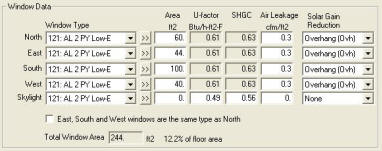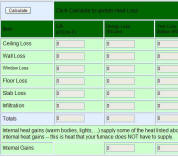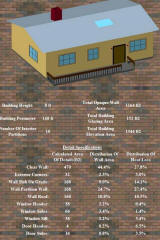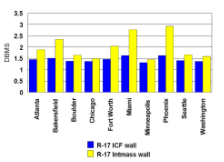|
Home Heat Loss/Gain and Passive Solar Home Design Software |
HEED
http://www.energy-design-tools.aud.ucla.edu/heed/
|
 This
is very easy to use, yet very capable simulation software for estimating the
energy/thermal performance of a passive solar or conventional home.
Weather files for over 700 worldwide locations. While it initially appears almost too simple,
by using the "advanced tab" it can handle a wide variety of situations.
It uses a one hour simulation time step, and weather files that cover a full
year of typical weather. It has been carefully validated. This
is very easy to use, yet very capable simulation software for estimating the
energy/thermal performance of a passive solar or conventional home.
Weather files for over 700 worldwide locations. While it initially appears almost too simple,
by using the "advanced tab" it can handle a wide variety of situations.
It uses a one hour simulation time step, and weather files that cover a full
year of typical weather. It has been carefully validated.
It is
limited to 1 zone, and does not handle sunspaces. It is a free
download.
For people outside of California: Here is how to get and use a
weather
file for your area with HEED. |
| How Much
Collector Area Do I Need To Heat My House? Or, Estimating Solar Heating
Fraction
Estimating Solar Fraction for an array of
collectors... A simpler example on using Andy's simulation:
using
the simulation to estimate energy, fuel, and CO2 savings for a collector
array... |
 This
is a question I get asked a lot. Its a tough question that depends on
many things, but here is a method that you can use to get a pretty good idea
what your solar faction is likely to be for
your collector array... This
is a question I get asked a lot. Its a tough question that depends on
many things, but here is a method that you can use to get a pretty good idea
what your solar faction is likely to be for
your collector array...Its fairly lengthy to use, but not difficult. |
| Resfen
http://windows.lbl.gov/software/resfen/resfen.htm
For precompiled Resfen data on many window types for many locations, use
the "Window Selection" tool here:
http://www.efficientwindows.org
|
 Resfen
allows detailed analysis of window choices for a wide variety of windows.
It is a full hourly simulation, and offers weather files for many locations.
Easy to use. |
| Energy10
http://www.nrel.gov/buildings/energy10/
|
 ENERGY-10
is a PC-based design tool that helps building designers quickly identify the
most cost-effective, energy-saving measures for small commercial and
residential buildings. It supports rapid comparisons of energy saving
strategies. Limited to 2 zones. ENERGY-10
is a PC-based design tool that helps building designers quickly identify the
most cost-effective, energy-saving measures for small commercial and
residential buildings. It supports rapid comparisons of energy saving
strategies. Limited to 2 zones.
Cost is $300, or $60 for students -- just
think how much energy would be saved if this program was made free! |
| Calculators: Passive solar heating, overhangs, thermal mass, heat loss, radiant heating... |
Borst Engineering and Construction provides a number of calculators that are helpful for solar heating, and renewable energy applications.
They are a small engineering consulting and analysis business -- "We are do-it-yourselfers (DIY) at heart and we support like-minded people"
|
Simple Home Heat Loss Calculators
These simple calculators are not simulations and will give less exact
numbers than the ones listed above, but you may find them easier and
quicker to use, and they do give reasonably accurate estimates of heat loss. |
|
Insulation Upgrade
Cost Saving Calculator Gary |
 Calculate
how much money and greenhouse gas you would save with various insulation,
window, or window treatment upgrades. Calculate
how much money and greenhouse gas you would save with various insulation,
window, or window treatment upgrades.Very easy to use. |
|
Home Heat Loss Calculator
Gary |
 This
is a simple home heat loss calculator. It provides rough estimates of
design heat loss (for furnace sizing), yearly heat loss, greenhouse gas
emissions, and estimated yearly fuel bills. This
is a simple home heat loss calculator. It provides rough estimates of
design heat loss (for furnace sizing), yearly heat loss, greenhouse gas
emissions, and estimated yearly fuel bills. |
|
Thermal Performance of Walls -- Including Walls with
Thermal Mass |
| Whole Wall Heat Loss Calculator
Oak Ridge National Laboratory
http://www.ornl.gov
And,
Home Energy Magazine Article
|
 An
online calculator to estimate the R value of entire walls, including the
areas where R value is reduced by corners, window frames, door frames etc. An
online calculator to estimate the R value of entire walls, including the
areas where R value is reduced by corners, window frames, door frames etc.
Works for a wide variety of wall constructions.
Results based on testing of actual wall sections. |
|
Thermal Mass - Energy Savings Potential in Residential Buildings
ORNL Paper
|
 ORNL
study of the benefits of incorporating thermal mass in walls, and comparing
different layerings of thermal mass and insulation. ORNL
study of the benefits of incorporating thermal mass in walls, and comparing
different layerings of thermal mass and insulation. |
|
R Values of Materials |
| R values for typical Building
Materials
http://coloradoenergy.org/procorner/stuff/r-values.htm
|
Table of R values for typical
insulators and building materials. |
|
Infiltration Heat Loss |
| Infiltration Heat Loss
http://coloradoenergy.org/procorner
/forumulas/air_infiltration.htm |
Estimating the saving for reducing
infiltration heat loss. |
|
Moisture Sources in the Home |
|
Home Moisture Sources |
Common sources of moisture in the
home with amounts of moisture for each. |
|
Home Energy Audit |
| An Interactive Tool for Saving
Energy at Home
Interactive Home Energy Saving Tool
|
 A
cute new tool from Energy Star that identifies energy saving tips on a room
by room basis. A
cute new tool from Energy Star that identifies energy saving tips on a room
by room basis.
You can give to your kids, and let them nag you into making some energy
saving changes to make the planet better for them. |
| Energy Savers from DOE EERE site
http://www.eere.energy.gov/consumer/tips/
Energy Tips from EERE
(2.7MB pdf) |
 "Energy Savers" for home owners (insulation,
appliances, lighting, ...) energy saving advice. "Energy Savers" for home owners (insulation,
appliances, lighting, ...) energy saving advice.The Energy Tips 36 page
booklet is good. |
| Energy Star Home Energy Yardstick
http://www.energystar.gov
|
 A
helpful and easy to use Energy Star calculator you can use to see how your
homes energy efficiency compares to others in your area. A
helpful and easy to use Energy Star calculator you can use to see how your
homes energy efficiency compares to others in your area. |
| Home Energy Saver Audit/Calculator
http://hes.lbl.gov/
|
 A Do-It-Yourself home energy audit A Do-It-Yourself home energy auditFill in details on your home location,
size, construction, etc. The calculator estimates your current energy
use, makes recommendations on changes and estimates the cost saving and
pollution benefits. |

 This
is very easy to use, yet very capable simulation software for estimating the
energy/thermal performance of a passive solar or conventional home.
Weather files for over 700 worldwide locations. While it initially appears almost too simple,
by using the "advanced tab" it can handle a wide variety of situations.
It uses a one hour simulation time step, and weather files that cover a full
year of typical weather. It has been carefully validated.
This
is very easy to use, yet very capable simulation software for estimating the
energy/thermal performance of a passive solar or conventional home.
Weather files for over 700 worldwide locations. While it initially appears almost too simple,
by using the "advanced tab" it can handle a wide variety of situations.
It uses a one hour simulation time step, and weather files that cover a full
year of typical weather. It has been carefully validated.
 This
is a question I get asked a lot. Its a tough question that depends on
many things, but here is a method that you can use to get a pretty good idea
what
This
is a question I get asked a lot. Its a tough question that depends on
many things, but here is a method that you can use to get a pretty good idea
what 
 ENERGY-10
is a PC-based design tool that helps building designers quickly identify the
most cost-effective, energy-saving measures for small commercial and
residential buildings. It supports rapid comparisons of energy saving
strategies. Limited to 2 zones.
ENERGY-10
is a PC-based design tool that helps building designers quickly identify the
most cost-effective, energy-saving measures for small commercial and
residential buildings. It supports rapid comparisons of energy saving
strategies. Limited to 2 zones. Calculate
how much money and greenhouse gas you would save with various insulation,
window, or window treatment upgrades.
Calculate
how much money and greenhouse gas you would save with various insulation,
window, or window treatment upgrades. This
is a simple home heat loss calculator. It provides rough estimates of
design heat loss (for furnace sizing), yearly heat loss, greenhouse gas
emissions, and estimated yearly fuel bills.
This
is a simple home heat loss calculator. It provides rough estimates of
design heat loss (for furnace sizing), yearly heat loss, greenhouse gas
emissions, and estimated yearly fuel bills. An
online calculator to estimate the R value of entire walls, including the
areas where R value is reduced by corners, window frames, door frames etc.
An
online calculator to estimate the R value of entire walls, including the
areas where R value is reduced by corners, window frames, door frames etc. ORNL
study of the benefits of incorporating thermal mass in walls, and comparing
different layerings of thermal mass and insulation.
ORNL
study of the benefits of incorporating thermal mass in walls, and comparing
different layerings of thermal mass and insulation. A
cute new tool from Energy Star that identifies energy saving tips on a room
by room basis.
A
cute new tool from Energy Star that identifies energy saving tips on a room
by room basis.  "Energy Savers" for home owners (insulation,
appliances, lighting, ...) energy saving advice.
"Energy Savers" for home owners (insulation,
appliances, lighting, ...) energy saving advice. A
helpful and easy to use Energy Star calculator you can use to see how your
homes energy efficiency compares to others in your area.
A
helpful and easy to use Energy Star calculator you can use to see how your
homes energy efficiency compares to others in your area. A Do-It-Yourself home energy audit
A Do-It-Yourself home energy audit